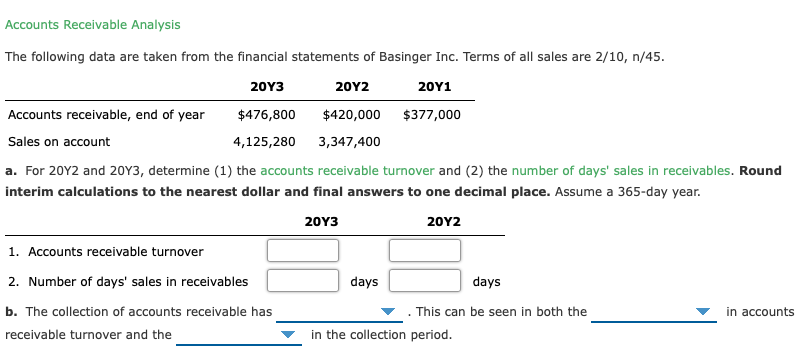The following data are taken from the financial statements of Basinger Inc. Terms of all sales are 2/10, n/45. 20Y3 20Υ2 20Y1 Accounts receivable, end of year $476,800 $420,000 $377,000 Sales on account 4,125,280 3,347,400 a. For 20Y2 and 20Y3, determine (1) the accounts receivable turnover and (2) the number of days' sales in receivables. Round interim calculations to the nearest dollar and final answers to one decimal place. Assume a 365-day year. 20Υ3 20Y2 1. Accounts receivable turnover 2. Number of days' sales in receivables days days b. The collection of accounts receivable has receivable turnover and the This can be seen in both the in accounts in the collection period.
The following data are taken from the financial statements of Basinger Inc. Terms of all sales are 2/10, n/45. 20Y3 20Υ2 20Y1 Accounts receivable, end of year $476,800 $420,000 $377,000 Sales on account 4,125,280 3,347,400 a. For 20Y2 and 20Y3, determine (1) the accounts receivable turnover and (2) the number of days' sales in receivables. Round interim calculations to the nearest dollar and final answers to one decimal place. Assume a 365-day year. 20Υ3 20Y2 1. Accounts receivable turnover 2. Number of days' sales in receivables days days b. The collection of accounts receivable has receivable turnover and the This can be seen in both the in accounts in the collection period.
Managerial Accounting
15th Edition
ISBN:9781337912020
Author:Carl Warren, Ph.d. Cma William B. Tayler
Publisher:Carl Warren, Ph.d. Cma William B. Tayler
Chapter16: Financial Statement Analysis
Section: Chapter Questions
Problem 9E
Related questions
Question

Transcribed Image Text:Accounts Receivable Analysis
The following data are taken from the financial statements of Basinger Inc. Terms of all sales are 2/10, n/45.
20Υ3
20Y2
20Y1
Accounts receivable, end of year
$476,800
$420,000
$377,000
Sales on account
4,125,280
3,347,400
a. For 20Y2 and 20Y3, determine (1) the accounts receivable turnover and (2) the number of days' sales in receivables. Round
interim calculations to the nearest dollar and final answers to one decimal place. Assume a 365-day year.
20Y3
20Υ2
1. Accounts receivable turnover
2. Number of days' sales in receivables
days
days
b. The collection of accounts receivable has
This can be seen in both the
in accounts
receivable turnover and the
in the collection period.
Expert Solution
Step 1
Formula:
Accounts receivable turnover = Net credit sales / Average accounts receivables.
Division of net credit sales with average accounts receivable derives the Accounts receivable turnover ratio.
Trending now
This is a popular solution!
Step by step
Solved in 2 steps

Knowledge Booster
Learn more about
Need a deep-dive on the concept behind this application? Look no further. Learn more about this topic, accounting and related others by exploring similar questions and additional content below.Recommended textbooks for you

Managerial Accounting
Accounting
ISBN:
9781337912020
Author:
Carl Warren, Ph.d. Cma William B. Tayler
Publisher:
South-Western College Pub

College Accounting, Chapters 1-27
Accounting
ISBN:
9781337794756
Author:
HEINTZ, James A.
Publisher:
Cengage Learning,

Managerial Accounting: The Cornerstone of Busines…
Accounting
ISBN:
9781337115773
Author:
Maryanne M. Mowen, Don R. Hansen, Dan L. Heitger
Publisher:
Cengage Learning

Managerial Accounting
Accounting
ISBN:
9781337912020
Author:
Carl Warren, Ph.d. Cma William B. Tayler
Publisher:
South-Western College Pub

College Accounting, Chapters 1-27
Accounting
ISBN:
9781337794756
Author:
HEINTZ, James A.
Publisher:
Cengage Learning,

Managerial Accounting: The Cornerstone of Busines…
Accounting
ISBN:
9781337115773
Author:
Maryanne M. Mowen, Don R. Hansen, Dan L. Heitger
Publisher:
Cengage Learning

Cornerstones of Financial Accounting
Accounting
ISBN:
9781337690881
Author:
Jay Rich, Jeff Jones
Publisher:
Cengage Learning

College Accounting, Chapters 1-27 (New in Account…
Accounting
ISBN:
9781305666160
Author:
James A. Heintz, Robert W. Parry
Publisher:
Cengage Learning

Survey of Accounting (Accounting I)
Accounting
ISBN:
9781305961883
Author:
Carl Warren
Publisher:
Cengage Learning